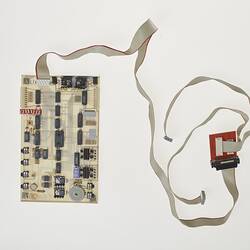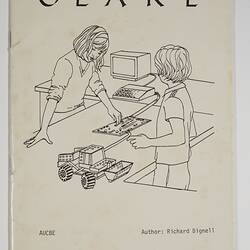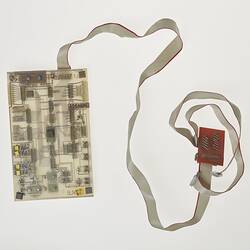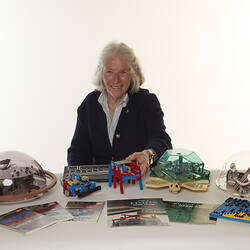Summary
The Clare Robot was developed in the UK by AUCBE (Advisory Unit for Computer Based Education) in the mid 1980s. It was designed for use with everyday items one could purchase from the local hardware store. It worked with a BBC micro computer and used Logo language. The user manual was authored by Richard Brignell.
The robot included a motherboard, ribbon cable plug to connect to the micro computer, a technical manual and a user guide.
This Clare robot was owned by Dr. Liddy Nevile and formed part of her collection of early educational robots. This object forms part of the Sunrise Collection which includes educational robots, software and multimedia recordings of teachers and students, mainly in Victoria, exploring new possibilities with computer programming.
Physical Description
The robotic toy comprises a hemispherical case of transparent grey acrylic with a flat flange, to which a clear circular acrylic base, separated by a 15 mm gap, is joined at four points on the periphery with bakelite and spring-steel bump sensors. There is a small triangular label with a green logo and black, printed text on the top surface of the base. A freely-moving, light-brown moulded plastic ring, approximately 40 mm larger in diameter than the domed case, is positioned in the gap above the base. The ring is broken at one point and a short strip of green pastic tape is stuck at one side of the break. There are two black rubber wheels protruding through slots in the base and two domed timber supports joined to the base with metal screws. Internally there are two metal-cased motors, one to each wheel; a stack of three microprocessor circuit boards, multi-coloured cables and wires, a small speaker and two green and four red light-emitting diodes. A 25-pin male 'D-shape' connector socket is fixed near the top of the domed case. A circular shape 45 mm diameter of bright orangle plastic, with a superimposed smaller circle of blue paper, is fixed to the outer surface of the domed case.
More Information
-
Collection Names
-
Collecting Areas
Information & Communication, Childhood, Social Spaces & Youth
-
Used By
-
Made For
-
Date Made
-
Inscriptions
Label on base: 'TASMANIA / [logo] / We made it!'
-
Classification
-
Category
-
Discipline
-
Type of item
-
Keywords
Robots, Robotics, Robot Components, Computers, Computer Software, Computer Games, Computer Peripherals, Electronic Learning Aids, Education Programs, Education Kits, Educational Technology, Schools, Technology, Education, microworlds, constructionism






